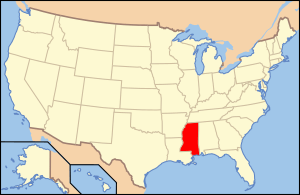Paleontology in Mississippi facts for kids

Paleontology is the study of fossils, which are the remains or traces of ancient life. In Mississippi, scientists have found many amazing fossils that tell us about the state's past. The oldest rocks in Mississippi are from the Late Devonian period. Back then, parts of Mississippi were covered by a sea where creatures like brachiopods, crinoids, and trilobites lived.
Later, during the Cretaceous period, a different sea covered the state. This sea was home to cephalopods, giant marine reptiles called mosasaurs, and sharks. On land, ancient trees left behind petrified wood and amber. By the Cenozoic Era, only the southern part of Mississippi was underwater. Here, early whales like Basilosaurus swam. On land, some of the earliest known primates lived in forests. Many fossils in Mississippi have been found by accident, often by people looking for fossil fuels. The fossils of the Eocene whales Basilosaurus cetoides and Zygorhiza kochii are the official state fossils of Mississippi.
Contents
Ancient Life in Mississippi
The oldest rocks in Mississippi are from the Late Devonian period. At that time, the northeastern part of the state was covered by a sea. In this ancient sea, creatures like brachiopods (shellfish), crinoids (sea lilies), molluscs, and trilobites (ancient arthropods) lived. Even parts of plants from the land ended up preserved in this sea.
Later, during the Late Carboniferous period, the sea moved away. A rich coastal plain appeared, covered with early trees and plants that looked like ferns. For a long time after that, new sediments were not laid down. This changed when the supercontinent Pangaea began to break apart.
Life in the Cretaceous Sea
During the Cretaceous period, a shallow sea covered Mississippi again. This sea was full of different kinds of life.
- Invertebrates: These included cephalopods (like squids and octopuses), tiny coccolithophores, coelenterates (like jellyfish), gastropods (snails), and oysters. There were also tube-shaped trace fossils called Halymenites major.
- Vertebrates: Large marine reptiles like the mosasaur Platecarpus tympaniticus swam in these waters. Many sharks also lived here, leaving behind lots of fossilized teeth.
Ancient Plants and Dinosaurs

Few plant fossils from the Cretaceous period are found in Mississippi. However, wood from ancient trees turned into petrified wood. Also, amber (fossilized tree sap) was found in Tishomingo County. Some pieces of amber even have tiny bits of leaves inside them. Fossil leaves from this time were also found near Fulton.
Both the older and Cretaceous fossils in Mississippi are found in the southern part of the state. This area is called the Gulf Coastal Plain. Believe it or not, dinosaurs also lived in Mississippi! Fossils of duck-billed dinosaurs and ostrich dinosaurs have been found. In 2016, a very rare tooth from a ceratopsian (a horned dinosaur like Triceratops) was discovered. This was only the third ceratopsian fossil ever found in the eastern U.S.
Life in the Cenozoic Era
In the early Cenozoic Era, the southern part of Mississippi was sometimes covered by a warm, tropical sea. During the Paleocene epoch, tiny creatures called foraminiferans and ostracods lived in Clay County. Bony fish, sharks, and early whales also swam in these seas.
The northern part of Mississippi was dry land during this time. It was covered by forests and swamps. Trees from these ancient forests left behind petrified wood. Some of the oldest known primate fossils in the world were found near Meridian.
During the Eocene epoch, Scott County was also home to foraminiferans and ostracods. Large oysters and the primitive whale Basilosaurus lived there too. As the Cenozoic Era continued, the climate in Mississippi became cooler. Fossils of freshwater molluscs and mammals from this cooler period have been found.
Fossil Discoveries and History
People have been finding fossils in Mississippi for a long time. The Choctaw people, who are native to Mississippi, had stories about giant creatures. These stories might have been influenced by the large bones they found, though they also mixed with other folklore.
Since paleontology became a formal science, many Cretaceous fossil sites have been found by accident. This often happened when people were searching for oil. Even before 1940, many such accidental discoveries were made. More recent fossils have also helped in the search for fossil fuels in Mississippi. For example, tiny Paleocene foraminiferans and ostracods in Clay County helped scientists find oil. Younger Eocene fossils of the same tiny creatures helped in Scott County.
Places to See Fossils
If you want to see some of Mississippi's amazing fossils, you can visit these places:
- Mississippi Petrified Forest
- Mississippi Museum of Natural Science, in Jackson


